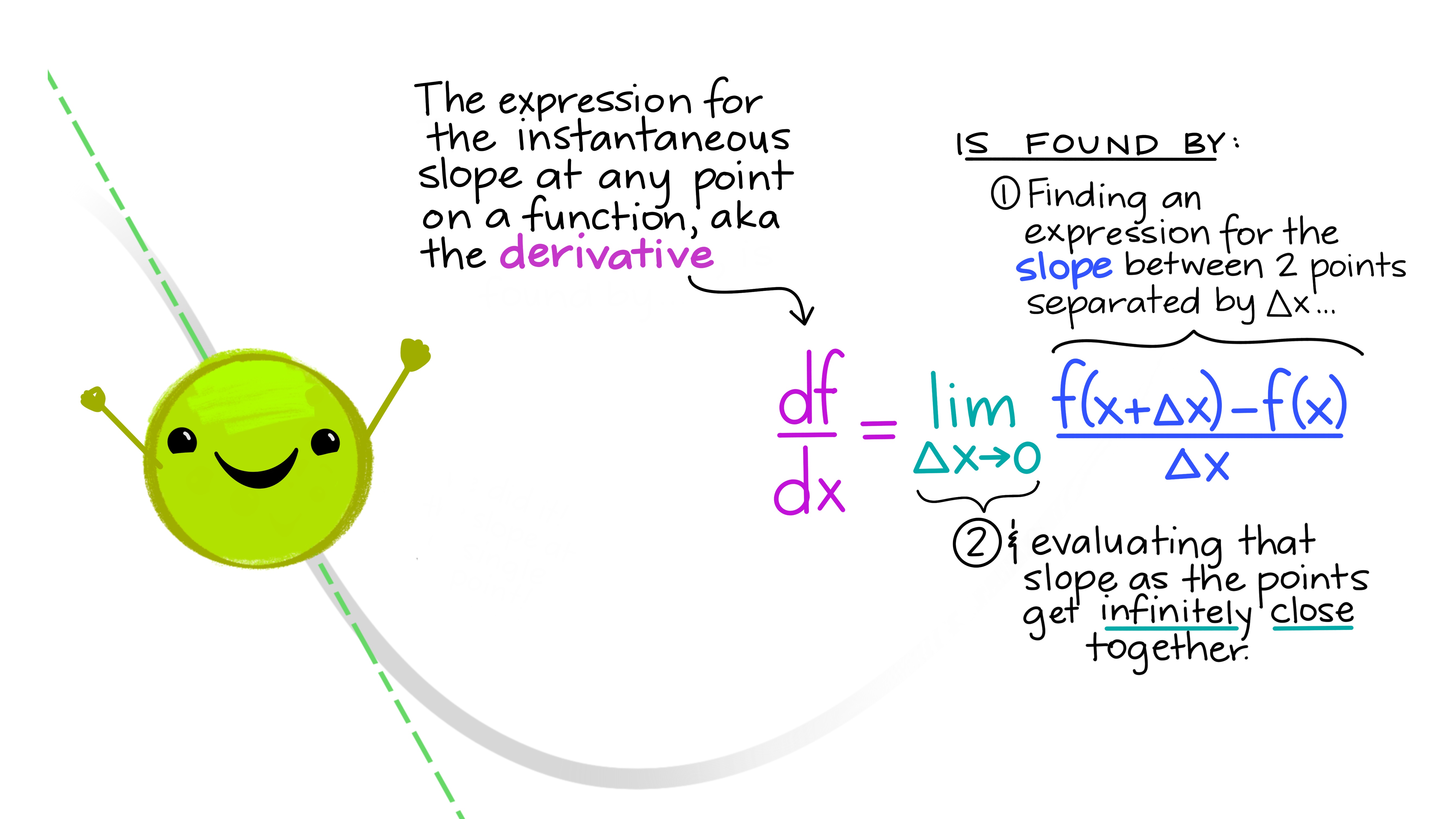Describing rates of change is common in environmental science (rate of pollutant concentration change, rate of population growth, rate of energy consumption)
EDS 212: Day 2, Lecture 2
Derivatives continued - higher order, partials, computation, & application
August 5th, 2025

Artwork by Allison Horst
\[\frac{df}{dx}=\lim_{\Delta x\to 0}\frac{f(x+\Delta x)-f(x)}{\Delta x}\]
(Alternatively, sub \(h\) for \(\Delta x\))
\[\frac{df}{dx}=\lim_{h\to 0}\frac{f(x+h)-f(x)}{h}\]
Why derivatives in an EDS program?
Practice interpretation / math think
Imagine you have a bowl of soup and you want to describe how quickly it cools off.
What do you think is the main driver of cooling?
What if you have a hot plate?
What does this look like in an equation?
Newton’s Law of Cooling
\[\frac{dT}{dt}=-k(T-T_a)+T_{in}\]
What do you think is wrapped up in \(k\)?
Higher order & partial derivatives
Higher order derivatives
Higher order derivatives are derivatives of derivatives.
Notation:
- First derivative: \(f'(x)\) or \(\frac{df}{dx}\)
- Second derivative: \(f''(x)\) or \(\frac{d^2f}{dx^2}\)
- Third derivative: \(f'''(x)\) or \(\frac{d^3f}{dx^3}\)
Higher order derivative example:
Find the 3rd derivative of:
\[G(z)=3z^4-8z^3+2z-19\] \[G'(z)=\frac{dG}{dz}=12z^3-24z^2+2\] \[G''(z)=\frac{d^2G}{dz^2}=36z^2-48z\] \[G'''(z)=\frac{d^3G}{dz^3}=72z-48\]
Partial derivatives
When we find a partial derivative, we find an expression for the slope with respect to one variable in a multivariate function.
Mathematically: Find the derivative with respect to a single variable, treating all others as constants.
Notation: the partials of \(f(x,y,z)\) are \(\frac{\partial f}{\partial x}\), \(\frac{\partial f}{\partial y}\), and \(\frac{\partial f}{\partial z}\)
Partial derivatives example:
Find all partials of:
\[B(x,T,\rho)=0.4x^3T-3.6T^2+4\rho x\] \[\frac{\partial B}{\partial x}=1.2x^2T+4\rho\] \[\frac{\partial B}{\partial T}=0.4x^3-7.2T\] \[\frac{\partial B}{\partial \rho}=4x\]
OK but what do partials actually mean?
The slope with respect to one variable if other variables are held constant. Let’s think about a roller coaster.
How can we describe our orientation? Let us count the ways…
[Commence drawing & handwaving extravaganza!]
Let’s try one
The temperature (in Celsius) across a surface (where x and y are in meters) is described by:
\[T(x,y)=x^2y-2x+y-1\]
At what “rate” is temperature changing (with respect to distance):
- In the \(x\) direction, at the point (1,3) on the surface?
- In the \(y\) direction, at the point (0,2) on the surface?
Another super real example
A dragon’s breath temperature (\(T\), in degrees Celsius) is modeled as a function of its wingspan (\(W\), in meters) and length (\(L\), also in meters):
\[T(W,L)=0.41WL+2.6W^2\]
- At what rate is breath temperature changing with respect to length for a dragon that is 4.1m long, with a wingspan of 4.5m?
- At what rate is breath temperature changing with respect to wingspan, for the same dragon?
Example: higher order & partial derivatives in environmental data science
The Advection-Dispersion-Reaction Equation for solute transport models the change in a solute concentration \(C\) over time \(t\), where groundwater is flowing in direction \(x\):
\[\frac{\partial C}{\partial t}=D_x \frac{\partial^2C}{\partial x^2} + D_y\frac{\partial^2C}{\partial y^2}+D_z\frac{\partial^2C}{\partial z^2}-v\frac{\partial C}{\partial x}-\lambda RC\]

Let’s break it down.
\[\frac{\partial C}{\partial t}=D_x \frac{\partial^2C}{\partial x^2} + D_y\frac{\partial^2C}{\partial y^2}+D_z\frac{\partial^2C}{\partial z^2}-v\frac{\partial C}{\partial x}-\lambda RC\]
- Left-hand-side: Rate of concentration change (over time)
- Right-hand-side first 3 terms: Concentration change due to dispersion in \(x\), \(y\), and \(z\) directions
- Right-hand-side fourth term: Concentration change due to groundwater transport (in groundwater flow direction, x)
- Right-hand-side final term: Reaction term (e.g. biodegradation / abiotic degradation)